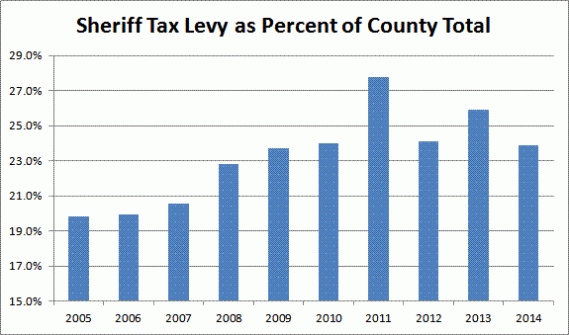One of Milwaukee County’s primary roles is to provide public safety services. These services include handling of emergency phone calls, coordinating emergency management programs after disasters, providing a radio network for first responders, and providing coordination of and training for Emergency Medical Services (EMS). Only coordination of emergency management is mandated by State Statute. County taxpayers provide a total of $10.9 million in tax levy funding for these services, which are staffed by 60 full-time positions.
Currently, these services are all fragmented across several County departments:
- Emergency Management services are located within the Office of the Sheriff. These services include coordination of disaster response, training, and policies and procedures, and are mandated by State Statute 323.14(1)(a)(2). For instance, this section manages an Emergency Operations Center, coordinates the County’s response to federal declarations of disasters after severe weather, and provides cross-jurisdictional training exercises related to mass-casualty responses. This section within the Office of the Sheriff includes six positions, including the County’s Emergency Management Director, one position dedicated to a federal emergency and disaster task force, and three emergency management service coordinators. Total tax levy in this section is $443,201.
- Emergency Communications & Dispatch, also located within the Office of the Sheriff, includes the County’s mobile 911 dispatch center, and is one of the County’s Public Safety Answering Points (PSAP) for mobile telephones. This section mainly receives 911 calls made by cellular telephones in municipalities other than the Cities of Milwaukee and Franklin, and those covered by the North Shore PSAP ( Bayside, Brown Deer, Fox Point, River Hills, Glendale, Shorewood & Whitefish Bay). Operators will relay calls to the correct 911 Dispatch Center, as necessary. Dispatch services are provided for Sheriff Deputies, District Attorney investigators and Medical Examiner investigators via the 800 MHz radio system. In 2013, the County entered into a contract in which the Milwaukee Police Department began automatically receiving such calls placed within city borders. This section includes 23 full-time positions, including 19 telecommunicators and three lead positions. Tax levy in this section totals $3,348,703.
- Emergency Medical Services, located in the Department of Health & Human Services (DHHS) provides regional dispatch services for paramedic units utilizing the 800 MHz radio system, communications for all Froedtert and Children’s Hospital transports, immediate medical direction control, education, health information management, medical supplies, quality assurance and dispatch guidelines for the Advanced Life Support (ALS) paramedic and the municipal fire department Basic Life Support (BLS) system on a contracted basis with all 19 municipalities in the County . This section has 30 full-time positions and a tax levy of $5,965,838.
- The Radio Services section of the Department of Administrative Services Information Management Services Division (DAS-IMSD) is responsible for maintaining the County’s various radio communications systems, including the new 800 Mhz Trunked Radio System, which provides radio access for most of the County’s municipalities, and which will be replaced in cooperation with Waukesha County. This section is staffed by one full-time position.
This fragmentation of responsibility for emergency-related public safety services has led to confusion and controversy over responsibility for maintaining equipment and facilities. For instance:
- The 911 dispatch center is located in a building managed by Department of Administrative Services – Facilities Management Division, making it responsible for building and other infrastructure maintenance.
- DAS-IMSD has responsibility for equipment related to the 911 dispatch system, but both DAS-IMSD and the Sheriff have at times budgeted for its replacement.
- One of the Emergency Medical Services’ core competencies within DHHS is regional radio communication and provider relationships; however its coordination with similar services in the Office of the Sheriff is unclear and could be leveraged to provide savings and service improvements.
- The County Emergency Operations Center (EOC) is operated in a Level 4 status by a Duty Officer under the Office of the Sheriff. The County Courthouse fire of July 2013 proved an urgent situation requiring the relocation resourcing of public services, a function of the County EOC. However, audible operations ensued, as this valuable resource remained dormant.
The Public Policy Form has recently studied the issue of consolidating 911 dispatch services in various parts of the County, and in 2014 the County considered but did not ultimately adopt a change in management of Emergency Management and Emergency Communications.
As the County continues to deal with significant fiscal pressures, alternative service delivery models should be considered. The following alternatives are available:
Consolidated Models – Waukesha, Brown, and Allegheny (PA) Counties
In Wisconsin Waueksha and Brown Counties have fully-consolidated Emergency Management Departments, with all of the above services located under one director who reports to the County Executive.
Waukesha County has a Department of Emergency Preparedness that includes the following service areas under the management of a Director of Emergency Preparedness:
- Countywide wireless 911 communications
- Emergency Management
- Radio Services
- Waukesha County has successfully consolidated dispatch services for 30 of the County’s 37 municipal agencies.
Brown County has a fully consolidated Emergency Management Department. The Department of Public Safety Communications provides 911 law enforcement, emergency medical dispatch services and radio communications. This consolidation occurred with the support of the Brown County Sheriff and in 2001 telecommunicators were transitioned from the Sheriff to the consolidated department. Unlike Milwaukee County, it has achieved consolidation of land-line emergency dispatch and radio services with some municipalities. Emergency Management services are a division within this department. This model is also utilized by Allegheny County, PA (Pittsburgh).
Dane County Model
Dane County provides these services in two separate departments: 911 dispatch is provided by a Department of Public Safety and Communications. Like Brown County, Dane County has achieved significant consolidation of dispatch services with dozens of municipalities, and the County’s Sheriff and Medical Examiner, which saves significant taxpayer resources. Emergency Management services, including EMS coordination, is provided in a separate Department of Emergency Management. In this model, both departments report to the County Executive.
Discussion
There is no single best structure for emergency services. In Hennepin County, MN (Minneapolis), the Office of the Sheriff operates the 911 communications center while emergency management is a separate department and EMS services are coordinated by a local health system. In Ramsey County, MN (St. Paul), radio and 911 communications/dispatch are provided in one department while emergency management services are coordinated in another. As the County seeks to achieve savings both in its own operations and for other municipalities, it is important to consider how the structure of these various services might drive countywide efficiencies. Questions to consider include:
- Would combining Emergency Management, Radio, and/or EMS into a single department drive efficiencies both countywide (in the form of reduced administrative staff, better coordination of contracts, etc.) and across jurisdictions? In Brown, Dane and Waukesha Counties these functions are managed by the Executive Branch of County Government. One advantage of consolidated reporting under a single elected official is the ability to create a common direction and integrated policies.
- Would combining these services make it more achievable to implement consolidation efforts with other municipalities as has happened in Brown, Dane, and Waukesha Counties? During the implementation of the new 800 Mhz Trunked Radio System, it has become clear that several municipalities will soon need to replace dispatch and other communications equipment and infrastructure. A consolidated system could save taxpayers in these municipalities significant resources through economies of scale and better pricing models.
- Consolidation of these services within one department will make it easier to create and track progress towards performance measures. Currently no one program area has total control over all operations, making performance evaluation difficult. Placing these services under one manager should improve accountability.

